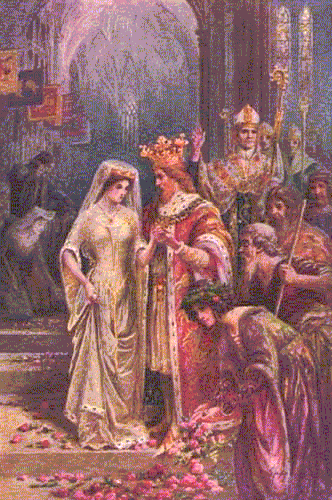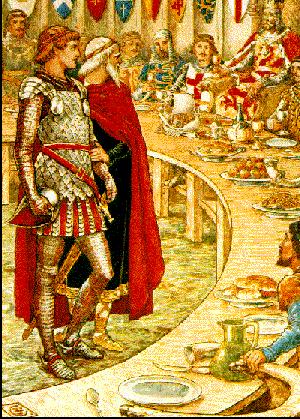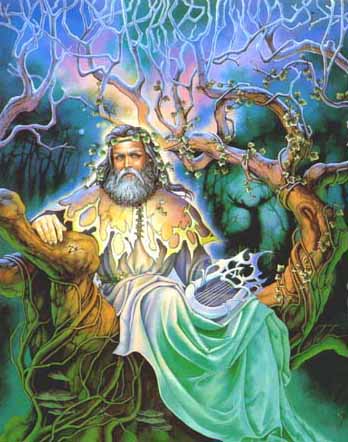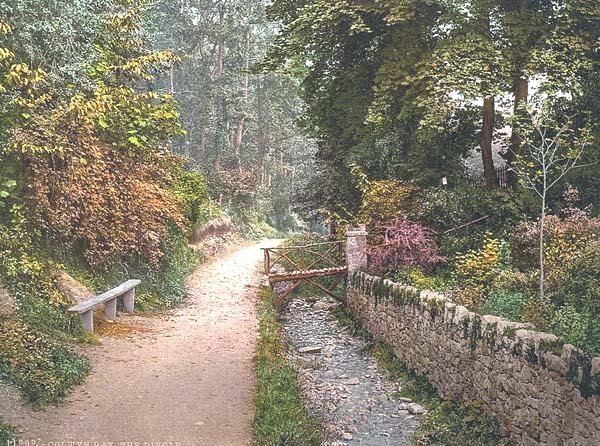The Theosophy
King Arthur Pages

King
Arthur’s
Marriage
to Guinevere
Chronology of
in the 5th Century CE
402 Events on
the continent force Stilicho to recall one of the two British legions to assist
with the defense of Italy against Alaric and the Visigoths. The recalled
legion, known as the Sixth Victrix, was said by Claudian (in "De Bello
Gallico," 416) to be "that legion which is stretched before the
remoter Britons, which curbs the Scot, and gazes on the tattoo-marks on the
pale face of the dying Pict." The barbarians were defeated, this time, at
battle of Pollentia
403
Victricius, Bishop of Rouen, visits Britain for the purpose of bringing peace
to the island's clergy, who were in the midst of a dispute, possibly over the
Pelagian heresy.
405 The
British troops, which had been recalled to assist Stilicho, do not return to
Britain as they have to stay in Italy to fight off another, deeper penetration
by the barbarian chieftain,Radagaisus.
406 In early
January, 406, a combined barbarian force (Suevi, Alans, Vandals &
Burgundians) sweep into central Gaul, severing contact between Rome and
Britain. In autumn 406, the remaining Roman army in Britain decides to mutiny. One
Marcus is proclaimed emperor in Britain, but is
immediately
assassinated.
407 In place
of the assassinated Marcus, Gratian is elevated "to the purple," but
lasts only four months. Constantine III is hailed as the new emperor by Roman
garrison in Britian. He proceeds to follow the example of Magnus Maximus by
withdrawing the remaining Roman legion, the Second Augusta, and crossing over
into Gaul to rally support for his cause.
Constantine's
departure could be what Nennius called "the end of the Roman Empire in
Britain. . ."
408 With both
Roman legions withdrawn, Britain endures devastating attacks by the Picts,
Scots and Saxons.
409 Prosper,
in his chronicle, says, "in the fifteenth year of Honorius and Arcadius
(409), on account of the languishing state of the Romans, the strength of the
Britons was brought to a desperate pass."
Under enormous
pressure, Britons take matters into their own hands, expelling weak Roman
officials and fighting for
themselves.
410 Britain
gains "independence" from Rome. The Goths, under Alaric, sack Rome.
413 Pelagian
heresy said to have begun, by Prosper (Tiro) of Aquitaine in his
"Chronicle."
420 – 30
Pelagian heresy is outlawed in Rome (418), but in Britain, enjoys much support
from "pro-Celtic" faction. Traditionalists (pro-Romans) support Roman
church. During this time, according to Prosper, Britain is ruled by petty
"tyrants."
421 Honorius
issues a decree forbidding any Pelagians to come nearer to Rome than the
one-hundredth mile marker.
429 At the
request of Palladius, a British deacon, Pope Celestine I dispatches bishops
Germanus of Auxerre and Lupus of Troyes to Britain to combat Pelagian heresy.
While in Britain, Germanus, a former military man, leads Britons to
"Hallelujah" victory in Wales.
c. 432
Traditional dating for the beginning of St. Patrick's mission to
c. 438 Birth
of Ambrosius Aurelianus, scion of the leading Romano-British family on the
island.
c. 440 – 50 Period
of civil war and famine in Britain, caused by ruling council's weakness and
inability to deal with Pictish invasions; situation aggravated by tensions
between Pelagian/Roman factions. Vacated towns and cities in ruin. Migration of
pro-Roman citizens toward west. Country beginning to be divided,
geographically, along factional lines.
c. 441 Gallic
Chronicle records, prematurely, that "Britain, abandoned by the Romans,
passed into the power of the Saxons."
c. 445
Vortigern comes to power in Britain.
446 Britons
(probably the pro-Roman party) appeal to Aetius, Roman governor of Gaul, for
military assistance in their struggle against the Picts and the Irish (Scots).
No help could be sent, at this time, as Aetius had his hands full with Attila
the Hun.
c. 446
Vortigern authorizes the use of Saxon mercenaries, known as foederati, for the
defense of the northern parts against barbarian attack.
To guard
against further Irish incursions, Cunedda and his sons are moved from Manau Gododdin
in northern Britain to northwest Wales.
447 Second
visit of St. Germanus (this time accompanied by Severus, Bishop of Trier) to
Britain. Was this visit spiritually motivated, to combat a revived Pelagian
threat, or was Germanus sent in Aetius' stead, to do whatever he could to help
the desperate Britons?
c. 447
Britons, aroused to heroic effort, "inflicted a massacre" on their
enemies, the Picts and Irish, and are left in peace, for a brief time. Could
this heroic effort have been led, again, by St. Germanus?
c. 448 Death
of St. Germanus in Ravenna. Civil war and plague ravage Britain.
c. 450 In the
first year of Marcian and Valentinian, Hengest arrives on shores of Britain
with "3 keels" of warriors, and are welcomed by Vortigern. This event
is known in Latin as the "adventus Saxonum," the coming of the
Saxons.
c. 452
Increasing Saxon settlement in Britain. Hengest invites his son, Octha, from
Germany with "16 keels" of warriors, who occupy the northern lands,
to defend against the Picts. Picts never heard from, again.
c. 453
Increasing Saxon unrest. Raids on British towns and cities becoming more
frequent.
c. 456
Probably fictitious, but entirely believable, event in which Saxons massacre
300 leading British noblemen at phony "peace" conference. Ambrosius'
father, who may have been the leader of the pro-Roman faction, is probably
killed either during the Saxon uprising or this massacre.
c. 457 Death
of Vortigern. Vitalinus (Guitolinus) new leader of pro-Celtic Pelagian faction.
Battle of Aylesford (Kent) in which Ambrosius, along with sons of Vortigern,
Vortimer and Cateyrn, defeat Hengest for the first time.
c. 458 Saxon
uprising in full-swing. Hengest finally conquers Kent, in South Eastern
Britain.
c. 458 – 60
Full-scale migration of British aristocrats and city-dwellers across the
English Channel to Brittany, in North Western Gaul (the "second
migration"). British contingent led by Riothamus (perhaps a title, not a
name), thought by some to be the original figure behind the legends of Arthur.
c. 460 – 70
Ambrosius Aurelianus takes full control of the pro-Roman faction and British
resistance effort; leads Britons in years of back-and-forth fighting with
Saxons. British strategy seems to have been to allow Saxon landings and to then
contain them, there.
c. 465 Arthur
probably born around this time.
c. 466 Battle
of Wippedesfleot, in which Saxons defeat Britons, but with great slaughter on
both sides. Mutual "disgust and sorrow" results in a respite from
fighting "for a long time."
c. 466 – 73
Period of minimal Saxon activity. Refortification of ancient hillforts and
construction of the Wansdyke probably takes place during
this time.
c. 469 Roman
emperor, Anthemius, appeals to Britons for military help against Visigoths.
c. 470 Battle
of Wallop (Hampshire) where Ambrosius defeats Vitalinus, head of the opposing
faction. Ambrosius assumes High-kingship of Britain.
473 Men of
Kent, under Hengest, move westward, driving Britons back before them "as
one flees fire."
477 Saxon
chieftain, Aelle, lands on Sussex coast with his sons. Britons engage him upon
landing but his superior force drives them into the forest (Weald). Over next
nine years, Saxon coastal holdings are gradually expanded in Sussex.
c. 480 Vita
Germani, the Life of St. Germanus, is written by a continental biographer,
Constantius.
c. 485 – 96 Period
of Arthur's "twelve battles" during which he gains reputation for
invincibility.
486 Aelle and
his sons overreach their normal territory and are engaged by Britons at battle
of Mercredesburne. Battle is bloody, but indecisive, and ends with both sides
pledging friendship.
c. 490 Hengest
dies. His son, Aesc, takes over and rules for 34 years.
c. 495 Cerdic
and Cynric, his son, land somewhere on the south coast, probably near the
Hampshire-Dorset border.
c. 496 Britons,
under overall command of Ambrosius and battlefield command of the "war
leader" Arthur, defeat Saxons at the Siege of Mount Badon.
c. 496 – 550
Following the victory at Mt. Badon, the Saxon advance is halted with the
invaders returning to their own enclaves. A generation of
peace ensues.
Corrupt leadership, more civil turmoil, public forgetfulness and individual
apathy further erode Romano-British culture over next fifty years, making
Britain ripe for final Saxon "picking."
c. 500 – 50
Spread of Celtic monasticism throughout
Theosophy
Avalon

King
Arthur &
The
Round Table

Merlin
& The Tree of Life
Merlin the Magician
Born circa 400 CE ; Welsh: Myrddin;
Latin: Merlinus; English: Merlin.

The
Holy Grail
The Theosophy
King
Arthur Pages
____________________
General pages
about Wales, Welsh History
and The History
of Theosophy in Wales
Theosophy links
Cardiff
Theosophical Society Website
The
National Wales Theosophy Website
If you
run a Theosophy Group, please feel
free
to use any material on this site.
The Most Basic Theosophy
Website in the Universe
A quick overview of Theosophy
and the Theosophical Society
If you run a Theosophy Group you
can use this as an introductory handout.
Theosophy Cardiff’s Instant Guide
Independent Theosophical Blog
One liners and quick explanations
About aspects of Theosophy
H P Blavatsky is usually
the only
Theosophist that most
people have ever
heard of. Let’s put that
right
The Voice of the Silence Website
An
Independent Theosophical Republic
Links
to Free Online Theosophy
Study
Resources; Courses, Writings,
The main criteria
for the inclusion of
links on this
site is that they have some
relationship
(however tenuous) to Theosophy
and are
lightweight, amusing or entertaining.
Topics include
Quantum Theory and Socks,
Dick Dastardly
and Legendary Blues Singers.
A selection of articles on Reincarnation
by Theosophical writers
Provided in response to the large
number of enquiries we receive at
Cardiff Theosophical Society on this subject
The Voice of the Silence Website
Lentil burgers, a
thousand press ups before breakfast and
the daily 25 mile
run may put it off for a while but death
seems to get most
of us in the end. We are pleased to
present for your
consideration, a definitive work on the
subject by a
Student of Katherine Tingley entitled
It’s all “water
under the bridge” but everything you do
makes an imprint
on the Space-Time Continuum.
No
Aardvarks were harmed in the
Within the
British Isles, The Adyar Theosophical Society has Groups in;
Bangor*Basingstoke*Billericay*Birmingham*Blackburn*Bolton*Bournemouth
Bradford*Bristol*Camberley*Cardiff*Chester*Conwy*Coventry*Dundee*Edinburgh
Folkstone*Glasgow*Grimsby*Inverness*Isle
of Man*Lancaster*Leeds*Leicester
Letchworth*London*Manchester*Merseyside*Middlesborough*Newcastle
upon Tyne
North
Devon*Northampton*Northern Ireland*Norwich*Nottingham
Perth*Republic of
Ireland*Sidmouth*Southport*Sussex*Swansea*Torbay
Tunbridge
Wells*Wallasey*Warrington*Wembley*Winchester*Worthing
The Spiritual Home of Urban Theosophy
The Earth Base for Evolutionary Theosophy
The
Theosophy Cardiff Nirvana Pages
National
Wales Centre for Theosophy
Blavatsky
Wales Theosophy Group
Tekels Park,
Camberley, Surrey, England GU15 – 2LF
Article
describing Tekels Park and its much
cherished
wildlife by Theosophist and long
term Tekels Park
Resident Madeleine Leslie Smith
______________________
_______________________
Theosophy Cardiff Cancels its Affiliation
to the Adyar Based Theosophical Society
and becomes an independent body within
the Worldwide Theosophical Movement
Theosophy Birmingham (England)
The Birmingham Annie Besant Lodge
Theosophy Cardiff has links with the
__________________
The Theosophy Cardiff
Glastonbury Pages
The Theosophy Cardiff Guide to
The Theosophy Cardiff Guide to
The Theosophy Cardiff Guide to
The Terraced Maze of Glastonbury Tor
Glastonbury and
Joseph of Arimathea
The Grave of King Arthur & Guinevere
Views of Glastonbury High Street
The Theosophy Cardiff Guide to
__________________
Camberley, Surrey, England GU15 2LF
Concerns about the fate of the
wildlife as
Tekels Park is to be Sold to a
Developer
Concerns are raised about the fate of
the
wildlife as The Spiritual Retreat,
Tekels Park in Camberley, Surrey,
England is to be sold to a developer.
Tekels Park is a 50 acre woodland
park,
purchased for the Adyar Theosophical
In addition to concern about the
park,
many are worried about the future
of the Tekels Park Deer as they
Confusion as the Theoversity moves out of
Tekels Park to Southampton, Glastonbury &
Chorley in Lancashire while the leadership claim
that the Theosophical Society will carry on
using
Tekels Park despite its sale to a developer
Anyone planning a “Spiritual” stay at
the
Tekels Park Guest House should be
aware of the sale.
Future
of Tekels Park Badgers in Doubt
Party On! Tekels
Park Theosophy NOT
Tekels Park & the Loch Ness Monster
A Satirical view of
the sale of Tekels Park
in Camberley, Surrey
to a developer
The Toff’s Guide to the Sale of Tekels Park
What the men in top
hats have to
say about the sale
of Tekels Park
__________________________
An Outline of Theosophy
Charles Webster Leadbeater
Theosophy - What it is How is it Known?
The Method of Observation General Principles
The Three Great Truths Advantage Gained from this Knowledge
The Deity
The Divine Scheme The Constitution of Man
The True Man
Reincarnation
The Wider Outlook
Death Man’s Past and Future Cause and Effect
______________________________
A B C D EFG H IJ KL M N OP QR S T UV WXYZ
Complete Theosophical Glossary in Plain Text Format
1.22MB
Classic Introductory Theosophy
Text
A Text Book of Theosophy By C
What Theosophy Is From the Absolute to Man
The Formation of a Solar System The Evolution of Life
The Constitution of Man After Death Reincarnation
The Purpose of Life The Planetary Chains
The Result of Theosophical Study
Preface to the American Edition Introduction
Occultism and its Adepts The Theosophical Society
First Occult Experiences Teachings of Occult Philosophy
Later Occult Phenomena Appendix
Preface
Theosophy and the Masters General Principles
The Earth Chain Body and Astral Body Kama – Desire
Manas Of Reincarnation Reincarnation Continued
Karma Kama Loka
Devachan
Cycles
Arguments Supporting Reincarnation
Differentiation Of Species Missing Links
Psychic Laws, Forces, and Phenomena
Psychic Phenomena and Spiritualism
Quick Explanations with Links to More
Detailed Info
What is Theosophy ? Theosophy Defined (More Detail)
Three Fundamental Propositions Key Concepts of Theosophy
Cosmogenesis
Anthropogenesis
Root Races
Karma
Ascended Masters After Death States Reincarnation
The Seven Principles of Man Helena Petrovna Blavatsky
Colonel Henry Steel Olcott William Quan Judge
The Start of the Theosophical Society Theosophical Society Presidents
History of the Theosophical Society Glossaries of Theosophical Terms
History of the Theosophical Society in Wales
The Three Objectives of the Theosophical Society
Explanation of the Theosophical Society Emblem
Karma Fundamental Principles Laws: Natural and Man-Made The Law of Laws
The Eternal Now
Succession
Causation The Laws of Nature A Lesson of The Law
Karma Does Not Crush Apply This Law
Man in The Three Worlds Understand The Truth
Man and His Surroundings The Three Fates
The Pair of Triplets Thought, The Builder
Practical Meditation Will and Desire
The Mastery of Desire Two Other Points
The Third Thread Perfect Justice
Our Environment
Our Kith and Kin Our Nation
The Light for a Good Man Knowledge of Law The Opposing Schools
The More Modern View Self-Examination Out of the Past
Old Friendships
We Grow By Giving Collective Karma Family Karma
National Karma
India’s Karma
National Disasters
Try these if you are looking
for a
local Theosophy Group or Centre
UK Listing of Theosophical Groups
Please tell us about your UK Theosophy Group
General pages
about Wales, Welsh History
and The History
of Theosophy in Wales
Wales is a
Principality within the United Kingdom
and has an eastern
border with England. The land
area is just over
8,000 square miles. Snowdon in
North Wales is the
highest mountain at 3,650 feet.
The coastline is
almost 750 miles long. The population
of Wales as at the
2001 census is 2,946,200.
_____________________


